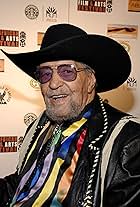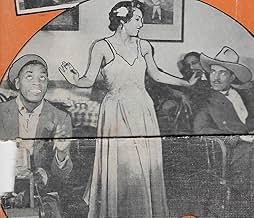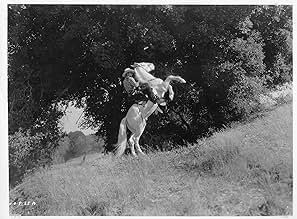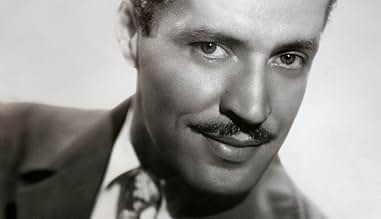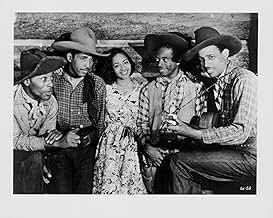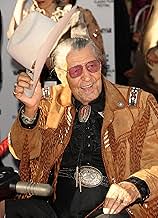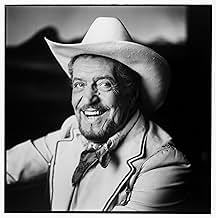Herb Jeffries(1913-2014)
- Actor
- Composer
- Director
This velvet-toned jazz baritone and sometime actor was (and perhaps
still is) virtually unknown to white audiences. Yet, back in the late
1930s and early 1940s, Herb Jeffries was very big...in black-cast
films. Today he is respected and remembered as a pioneer who broke down
rusted-shut racial doors in Hollywood and ultimately displayed a
positive image as a black actor on celluloid.
The Detroit native was born Umberto Alejandro Ballentino on September 24, 1911 (some sources list 1914). His white Irish mother ran a rooming house, and his father, whom he never knew, was of mixed ancestry and bore Sicilian, Ethiopean, French, Italian and Moorish roots. Young Herb grew up in a mixed neighborhood without experiencing severe racism as a child. He showed definitive interest in singing during his formative teenage years and was often found hanging out with the Howard Buntz Orchestra at various Detroit ballrooms.
After moving to Chicago, he performed in various clubs. One of his first gigs was in a club allegedly owned by Al Capone. Erskine Tate signed the 19-year-old Herb to a contract with his Orchestra at the Savoy Dance Hall in Chicago. While there Herb was spotted by Earl 'Fatha' Hines, who hired him in 1931 for a number of appearances and recordings. It was during the band's excursions to the South that Jeffries first encountered blatant segregation. He left the Hines band in 1934 and eventually planted roots in Los Angeles after touring with Blanche Calloway's band. There he found employment as a vocalist and emcee at the popular Club Alabam. And then came Duke Ellington, staying with his outfit for ten years. Herb started his singing career out as a lyrical tenor, but, on the advice of Duke Ellington's longtime music arranger, Billy Strayhorn, he lowered his range.
The tall, debonair, mustachioed, blue-eyed, light-complexioned man who had a handsome, matinée-styled Latin look, was a suitable specimen for what was called "sepia movies" -- pictures that played only in ghetto and/or segregated theaters and were advertised with an all-black cast. Inspired by the success of Gene Autry, Herb made his debut as a crooning cowboy with Harlem on the Prairie (1937), which was considered the first black western following the inauguration of the talkies. Dark makeup was applied to his light skin and he almost never took off his white stetson which would have revealed naturally brown hair. A popular movie, Herb went on to sing his own songs (to either his prairie flower and/or horse) in both The Bronze Buckaroo (1939) and Harlem Rides the Range (1939). Outside the western venue, he starred in the crimer Two-Gun Man from Harlem (1938). As the whip-snapping, pistol-toting, melody-gushing Bronze Buckaroo, Jeffries finally offered a positive alternative to the demeaning stereotypes laid on black actors. Moreover, he refused to appear in "white" films in which he would have been forced to play in servile support.
In the midst of all this, Herb continued to impress as a singer and made hit records of the singles "In My Solitude", "I Got It Bad and That Ain't Good", "When I Write My Song", Duke Ellington's "Jump for Joy" and his signature song "Flamingo", which became a huge hit in 1941. Some of the songs he did miss out on which could have furthered his name, were "Love Letters" and "Native Boy". During the 1950s Herb worked constantly in Europe, especially in France, where he owned his own Parisian nightclub for a time. He also starred in the title film role of Calypso Joe (1957) co-starring Angie Dickinson and later appeared on episodes of "I Dream of Jeannie", "The Virginian" and "Hawaii Five-0".
Although he very well could have with his light skin tones, the man dubbed "Mr. Flamingo" never tried to pass himself off as white. He was proud of his heritage and always identified himself as black. In the mid-1990s, westerns returned in vogue and Herb recorded a "comeback album" ("The Bronze Buckaroo Rides Again") for Warner Western. During this pleasant career renaissance he has also been asked to lecture at colleges, headline concerts and record CDs. In 1999-2000, at age 88, he recorded the CD "The Duke and I", recreating songs he did with Duke. It also was a tribute honoring the great musician's 100th birthday.
His five marriages, including one to notorious exotic dancer Tempest Storm, produced five children. At age 90-plus, Herb "Flamingo" Jeffries, lived in the Palm Springs area with significant other (and later his fifth wife) Savannah Shippen, who is 45 years his junior, remaining one of the last of the original singing cowboys still alive (along with Monte Hale) until he finally passed away on May 25, 2014, having hit the century mark.
In 2003 he was inducted into the Cowboy Hall of Fame and was invited to sing for President Bush at the White House. He is also the last surviving member of The Great Duke Ellington Orchestra, and certainly deserves proper credit for his historic efforts in films and music.
The Detroit native was born Umberto Alejandro Ballentino on September 24, 1911 (some sources list 1914). His white Irish mother ran a rooming house, and his father, whom he never knew, was of mixed ancestry and bore Sicilian, Ethiopean, French, Italian and Moorish roots. Young Herb grew up in a mixed neighborhood without experiencing severe racism as a child. He showed definitive interest in singing during his formative teenage years and was often found hanging out with the Howard Buntz Orchestra at various Detroit ballrooms.
After moving to Chicago, he performed in various clubs. One of his first gigs was in a club allegedly owned by Al Capone. Erskine Tate signed the 19-year-old Herb to a contract with his Orchestra at the Savoy Dance Hall in Chicago. While there Herb was spotted by Earl 'Fatha' Hines, who hired him in 1931 for a number of appearances and recordings. It was during the band's excursions to the South that Jeffries first encountered blatant segregation. He left the Hines band in 1934 and eventually planted roots in Los Angeles after touring with Blanche Calloway's band. There he found employment as a vocalist and emcee at the popular Club Alabam. And then came Duke Ellington, staying with his outfit for ten years. Herb started his singing career out as a lyrical tenor, but, on the advice of Duke Ellington's longtime music arranger, Billy Strayhorn, he lowered his range.
The tall, debonair, mustachioed, blue-eyed, light-complexioned man who had a handsome, matinée-styled Latin look, was a suitable specimen for what was called "sepia movies" -- pictures that played only in ghetto and/or segregated theaters and were advertised with an all-black cast. Inspired by the success of Gene Autry, Herb made his debut as a crooning cowboy with Harlem on the Prairie (1937), which was considered the first black western following the inauguration of the talkies. Dark makeup was applied to his light skin and he almost never took off his white stetson which would have revealed naturally brown hair. A popular movie, Herb went on to sing his own songs (to either his prairie flower and/or horse) in both The Bronze Buckaroo (1939) and Harlem Rides the Range (1939). Outside the western venue, he starred in the crimer Two-Gun Man from Harlem (1938). As the whip-snapping, pistol-toting, melody-gushing Bronze Buckaroo, Jeffries finally offered a positive alternative to the demeaning stereotypes laid on black actors. Moreover, he refused to appear in "white" films in which he would have been forced to play in servile support.
In the midst of all this, Herb continued to impress as a singer and made hit records of the singles "In My Solitude", "I Got It Bad and That Ain't Good", "When I Write My Song", Duke Ellington's "Jump for Joy" and his signature song "Flamingo", which became a huge hit in 1941. Some of the songs he did miss out on which could have furthered his name, were "Love Letters" and "Native Boy". During the 1950s Herb worked constantly in Europe, especially in France, where he owned his own Parisian nightclub for a time. He also starred in the title film role of Calypso Joe (1957) co-starring Angie Dickinson and later appeared on episodes of "I Dream of Jeannie", "The Virginian" and "Hawaii Five-0".
Although he very well could have with his light skin tones, the man dubbed "Mr. Flamingo" never tried to pass himself off as white. He was proud of his heritage and always identified himself as black. In the mid-1990s, westerns returned in vogue and Herb recorded a "comeback album" ("The Bronze Buckaroo Rides Again") for Warner Western. During this pleasant career renaissance he has also been asked to lecture at colleges, headline concerts and record CDs. In 1999-2000, at age 88, he recorded the CD "The Duke and I", recreating songs he did with Duke. It also was a tribute honoring the great musician's 100th birthday.
His five marriages, including one to notorious exotic dancer Tempest Storm, produced five children. At age 90-plus, Herb "Flamingo" Jeffries, lived in the Palm Springs area with significant other (and later his fifth wife) Savannah Shippen, who is 45 years his junior, remaining one of the last of the original singing cowboys still alive (along with Monte Hale) until he finally passed away on May 25, 2014, having hit the century mark.
In 2003 he was inducted into the Cowboy Hall of Fame and was invited to sing for President Bush at the White House. He is also the last surviving member of The Great Duke Ellington Orchestra, and certainly deserves proper credit for his historic efforts in films and music.
